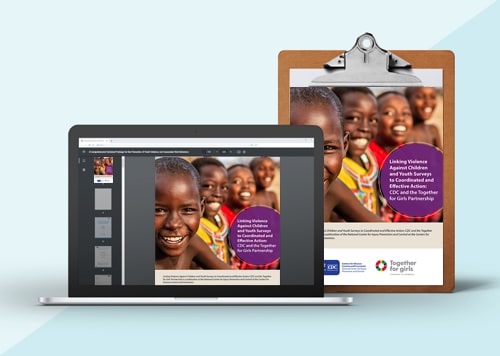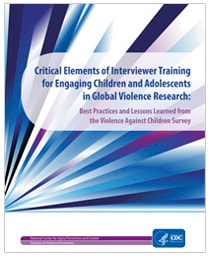Violence Against Children and Youth Survey Country Process

VACS Country Process: Country Engagement
VACS is country-led and driven, and typically a national government requests the VACS through a Together for Girlsexternal icon partner in-country. The success of VACS is based on the strong engagement of in-country partners. In order for the VACS to be successful, a number of factors need to be in place and are described in the table below.
Considerations when Undertaking the VACS |
|
|---|---|
| Programmatic Response |
|
| Ethical Standards |
|
| Process Sustainability |
|
| Survey Support |
|
| Funding Availability |
|
| Partner Support |
|
| In-Country Capacity |
|
The technical assistance provided by CDC helps countries prepare, implement, and respond to VACS. The role of CDC includes activities such as: protocol development, ethics approval, training, pilot testing, data collection, and analysis. CDC also supports the program and policy response following VACS implementation.
Preparing for VACS: Ethical Review and Protections
When preparing for the VACS, the survey protocol, questionnaire, and response plan are adapted to meet the needs of the local country. The survey protocol informs the survey process, sample, and design, and ensures survey questions are culturally relevant and suitable for the country. Country-specific adaptations are made to the core VACS protocol and questionnaire to ensure cultural relevance while maintaining consistency in methods and data definitions across countries. Due to the sensitive nature of the questions in the survey, some participants may recall painful experiences, which may cause a strong emotional response. To address these needs, a response plan is developed. The response plan and referral protocol outline the process for how those requiring assistance will be supported. During the survey, all participants are provided with a list of services, reflecting free programs, services, and amenities currently offered based on the country response plan.
VACS adheres to World Health Organization (WHO) recommendationsexternal icon on ethics and safety in studies of violence against women. Critical Elements of Interviewer Training for Engaging Children and Adolescents in Global Violence Research pdf icon[3 MB, 22 Pages] provides an overview of VACS procedures and protocols that ensure ethical protections of young people who participate in the VACS. CDC’s Institutional Review Board and an in-country ethics committee, or other entities which protect the rights and welfare of human research subjects, independently review and approve each survey protocol.
Implementing VACS: Survey Pilot Testing and Fieldwork
In all countries, interviewers conduct a field test of the survey procedures. The field test helps interviewers assess the field procedures, questionnaire administration, and interview and response plan processes. Following the field test, data collection begins. Data collection takes approximately 8–12 weeks in each country. In most countries, male interviewers conduct interviews with male participants, and female interviewers conduct interviews with female participants. In addition, VACS utilizes a “split sample” approach, where only males are interviewed in male enumeration areas, and females are interviewed in female enumeration areas. This split sample helps to protect the confidentiality of participants and eliminates the chance that a male perpetrator of sexual violence and the female victim in the same community would both be interviewed.
Responding to VACS: Data to Action and VACS Report Launch
After the data have been collected and analyzed, translating the data into meaningful prevention and response policies and programs is arguably the most important phase of the VACS and is an ongoing process. There are two main components of this phase: conducting a Data to Action process and launching a report of VACS results.
Establishing national priorities with Data to Action
The Data to Action process prioritizes areas of concern from VACS data and develops strategies based on the INSPIRE technical package. The emphasis is on building country capacity to develop a comprehensive, coordinated plan to end violence against children and youth.
One key milestone of the Data to Action process is a Data to Action Workshop led by the country government with assistance from coordinating, implementing, and lead statistical agencies, UNICEF, US Government partners, members of the multi-sector task force, as well as CDC. VACS Data to Action Workshops connect findings from the VACS with evidence-based and evidence-informed policies and programs to prevent and respond to violence and form the basis for a National Action Plan. The ideal timing of the workshop is between the release of preliminary findings from the VACS and the launch of the final VACS report.
In many countries, the National Action Plan is released with the final VACS results. While each country’s response is unique, it is essential that there are efforts to include implementation strategies and plans to track performance through monitoring and evaluation.
Launching the VACS Report
Launching a VACS report is an exciting and significant milestone in the VACS process. The release of the final report and action plan provides an ideal opportunity to bring increased attention to violence against children and youth, and incorporate country-specific interventions across sectors, including health, social welfare, justice, and education. This cross-sector collaboration directly supports Together for Girls’ model of building on existing platforms to prevent violence. Once the host country governments officially launch the final report, the reports and results of VACS are made publicly available online on the Together for Girls website.
While the launch of the final report is a significant milestone, it is not the end goal of the VACS. The public visibility of the launch assists in high-level engagement, intended to lead to increased support for coordinated national, multi-sectoral action in responding to the data. As the response process continues, monitoring and evaluation are important to tracking the performance of the efforts of VACS countries.

Linking Violence Against Children and Youth Surveys to Coordinated and Effective Action: CDC and the Together for Girls Partnership pdf icon[4.30 MB, 30 Pages, Print Only]external icon is a guide for countries interested in undertaking VACS and supporting data-informed actions to address the burden and consequences of violence against children and youth.
